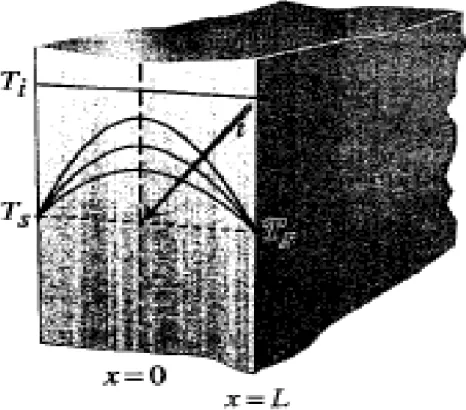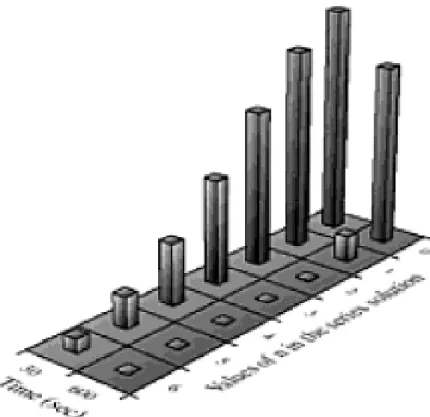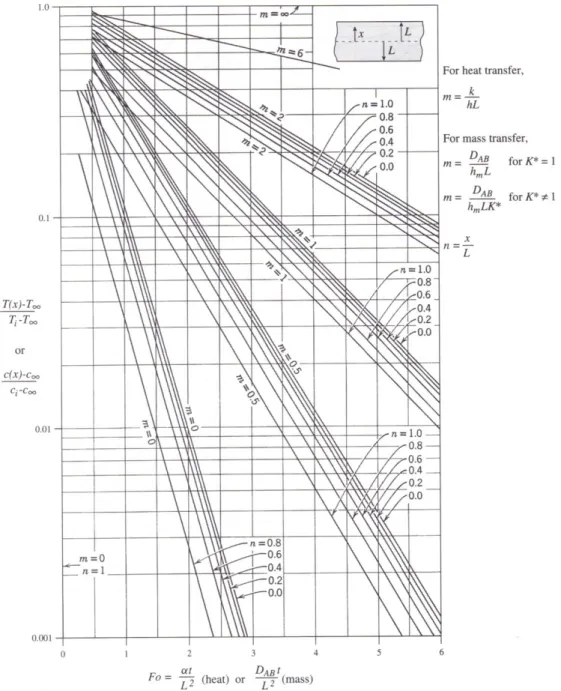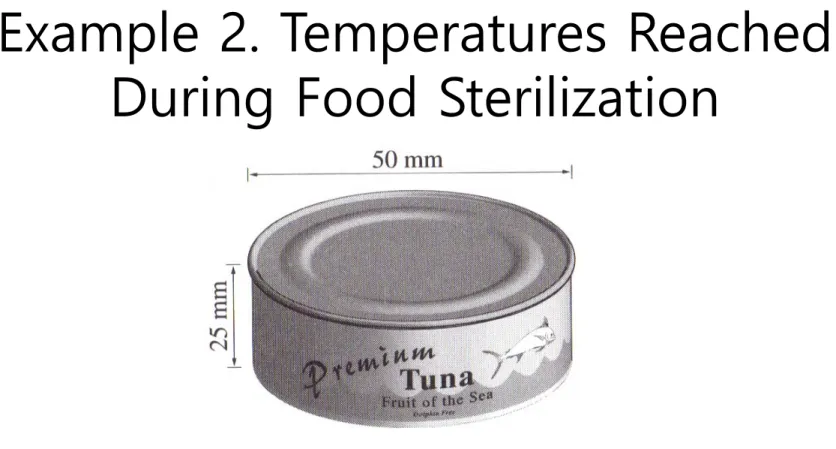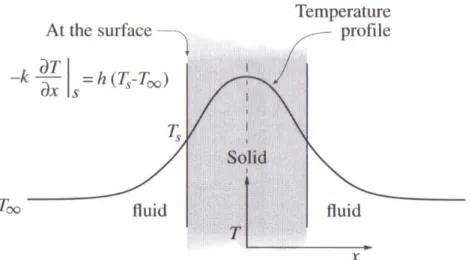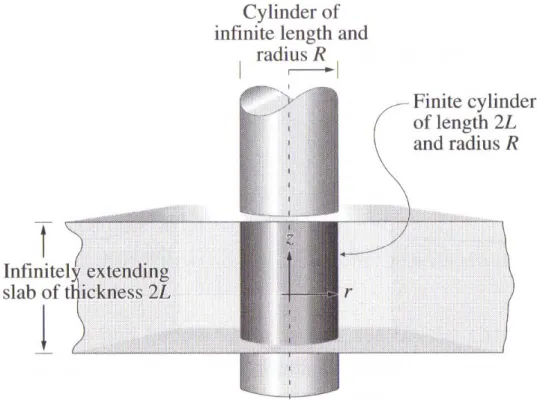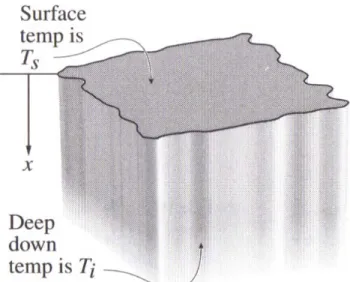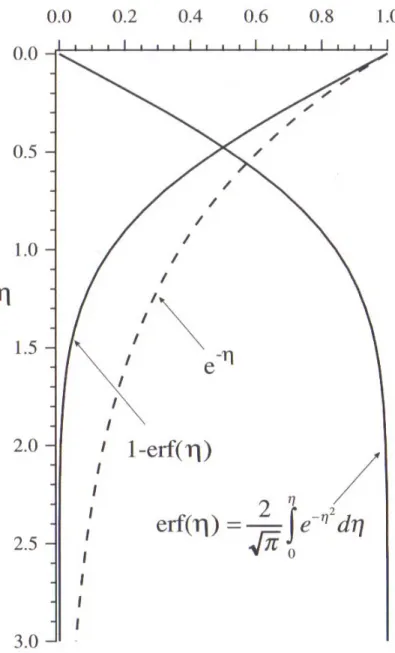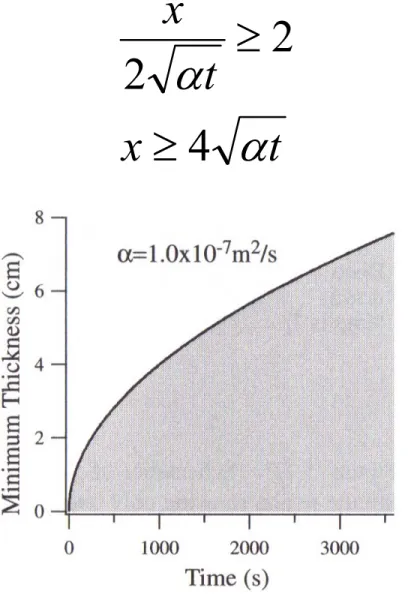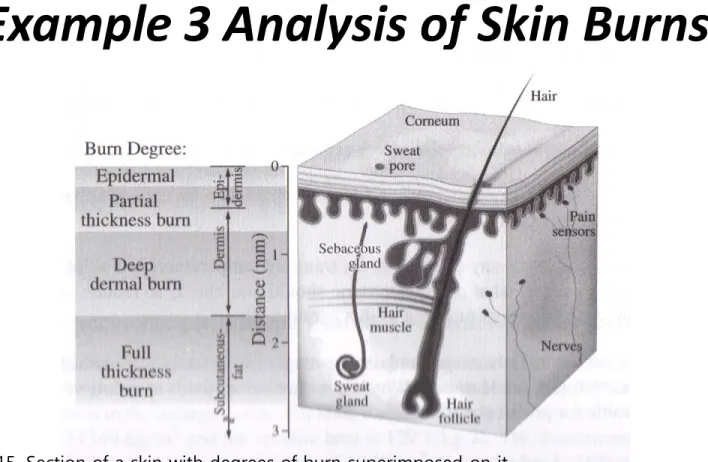Conduction Heat transfer:
Unsteady state
Chapter Objectives
For solving the situations that
– Where temperatures do not change with position.
– In a simple slab geometry where temperature vary also with position.
– Near the surface of a large body (semi‐infinite region)
Keywords
‐ Internal resistance
‐ External resistance
‐ Biot number
‐ Lumped parameter anaysis
‐ 1D and multi‐dimensional heat conduction
‐ Heisler charts
‐ Semi‐infinite region
1 Lumped Parameter Analysis
In transient, T
r=r= T
r=0.5r= T
r=0?
Tr=r
Tr=0.5r Tr=0
TSurr
Figure 1. Several temperatures in the system.
Lumped Parameter Analysis
Figure 2. A solid with convection over its surface.
)Δt T
hA(T ΔT
mC
p
(1))ΔΔ T
hA(T ΔT
mC
p
M : Mass
Cp: Specific heat
h : Convective heat transfer coefficient A : Surface area
T∞ : Bulk fluid temperature
(1)
(2)
Lumped Parameter Analysis
(3)
Lumped Parameter Analysis
(5) (4)
2 Biot Number
Tr=r
Tr=0.5r Tr=0
TSurr
Figure 3. Several temperatures in the system.
T
r=r= T
r=0.5r= T
r=0So, when can we apply ?
Biot Number
Bi (Biot Number)
: Deciding whether internal resistance can be ignored.
(6)
(7)
Characteristic Length
Characteristic length ≡ V/A
Path of least thermal resistance
Characteris c length↓
= Temperature can be changed in short time
Figure 4. Characteristic lengths for heat conduction in various geometries.
(8)
What is the temperature of the egg after 60min?
Figure 5. Schematic for Example 1.
Example 1
Known: Initial temperature of an egg
Find: Temperature of the egg after 60min.
Given data: T i = 20 ℃ T air = 38 ℃
h = 5.2 W/m2ㆍK ρ = 1035 kg/m3 Cp = 3350 J/kgㆍK k = 0.62 W/mㆍK
Being Bi <0.1, lumped analysis can be applied!
Assumption:
1. Egg is approximately spherical.
2. Surface heat transfer coefficient provided is an average value.
3. Lumped parameter analysis.
Bi (Biot Number) = hV / Ak = 0.07 < 0.1
Using (Eqn. 5),
Then, T = 29.1 ℃
Being Bi <0.1, lumped analysis can be applied!
Assumption:
1. Egg is approximately spherical.
2. Surface heat transfer coefficient provided is an average value.
3. Lumped parameter analysis.
Bi (Biot Number) = hV / Ak = 0.07 < 0.1
Using (Eqn.5),
Then, T = 29.1 ℃
3 When Internal Resistance Is Not Negligible
Tr=r
Tr=0.5r Tr=0
TSurr
Figure 1: Several temperatures in the system.
The situations, T
r=r≠ T
r=0.5r≠ T
r=0 (i.e. Bi ≥ 0.1)When Internal Resistance Is Not Negligible
Figure 6. Schematic of a slab showing the line of symmetry at x = 0 and the two surfcaes at x = L and at x = ‐L maintained at temperature TS. The material is very large (extends to infinity) in the other two directions.
When Internal Resistance Is Not Negligible
(9)
(10) (11)
Boundary conditions
When Internal Resistance Is Not Negligible
(12)
Initial condition
(13)
α (Thermal diffusivity) = k/ρCp
How Temperature Changes with Time
Figure 7. The terms in the series (n = 0, 1, ... in Equation 5.13) drop off rapidly for values of time. Calculations are for FO = 0.0048 at 30 s and FO = 0.096 at 600 s for a thickness of L = 0.03 m and a typical α = 1.44 x 10‐7m2/s for bio materials.
For visualizing Temperature vs. Position and Time, infinite series should be simplified
How Temperature Changes with Time
Comparing different terms at each time(t= 30s, t= 600s),
Contribution decays Gradually at t= 30s Rapidly at t= 600s
(15)
(16)
Temperature Change with Position and Spatial Average
• We can see that temperature varies as a cosine function
• Therefore, we need to define spatial average temperature
(15)
(16) L t
s i
s
e
L x T
T
T
T
2 2cos 2
4
L t L
x T
T
T T
s i
s
2
2 cos 2
ln 4
ln
Spatial average temperature
(17)
(18)
Applying (5.17) to (5.16) gives
Lav
Tdx
T L
0
1
L t T
T
T T
s i
s av
2
2
2
ln 8
ln
Temperature Change with Size
(19)
s i
s av
T T
T T
L t
ln 8
4
22 2
Charts Developed from the Solutions:
Their Uses and Limitations.
• It can be seen that temperature is a function of x/L and αt/L2
• Charts are developed because of the complexity of the calculation of series.
(20)
2 2 21 2
0
2
1 cos 2
1 2
1
4
n Ltn
n
s i
s
e
L x n
n T
T
T
T
• Charts are developed with the condition of n=0. In other words, it is a plot of Eqn. 5 And it is also called Heisler chart.
• There are some assumptions for the development of the charts.
These are:
1. Uniform initial temperature
2. Constant boundary fluid temperature 3. Perfect slab, cylinder or sphere
4. Far from edges
5. No heat generation (Q=0)
6. Constant thermal properties (k, α, cp are constants)
7. Typically for times long after initial times, given by αt/L2>0.2
Figure 8. Unsteady state diffusion in a large slab
Example 2. Temperatures Reached During Food Sterilization
• Surface temperature of a slab of tuna is suddenly increased
• Find the temperature at the center of the slab after 30 min
Figure 9. A cylindrical can containing food to be sterilized.
• Given data:
1. Thickness of slab = 25 mm 2. Thermal diffusivity of the slab, 3. Initial temperature = 40℃
4. Surface temperature = 121℃
5. Time of heating = 1800s
• Assumptions
1. Heating from the side is ignored 2. Thermal diffusivity is constant
s m / 10
2 7 2
So the temperature T = 120.65℃ after 30 minutes of heating
0125 0 .
0
0
L n x
0
hL m k
0 . 0125 / 1800 2 . 3
10 2
2 2 2 7
0
2
m
s s
m L
F t
0043 .
0
T T
T T
i
Convective Boundary Condition
• We have considered a negligible external fluid resistance to heat transfer.
• But if we consider external fluid resistance in addition to internal fluid resistance,
Figure 10. In convective boundary condition, surface temperature is not the same as the bulk fluid temperature, T∞, signifying additional fluid resistance .
• At the surface,
The solution is generalized form of Eqn. 5.13 and you can refer to Heisler chart as well.
h T T
x
k T
ss
Numerical Methods as Alternatives to the Charts
• In practice, however, such conditions dealt with above are not that simple
• Limitations of the analytical solutions can be overcome using numerical, computer‐based solutions
4 Transient Heat Transfer in a Finite Geometry‐Multi‐Dimensional Problems
• We should consider the situation two‐ and three‐dimensional effect yields
• A finite geometry is considered as the intersection of two or three infinite geometries
(21) slab z inite s
i
s t
z
slab y inite s
i
s t
y
slab x inite s
i
s t
x s
i
s t
xyz
T T
T T
T T
T T
T T
T T
T T
T T
inf ,
inf ,
inf , ,
Figure 11. A finite cylinder can be considered as an intersec tion of an infinite cylinder and a slab
slabinite s
i
s t
z
cylinderinite s
i
s t
r s
i
s t
z r
T T
T T
T T
T T
T T
T T
inf ,
inf ,
,
,
(22)5 Transient Heat Transfer in a Semi‐
infinite Region
• A semi‐infinite region extends to infinity in two directions and a single identifiable surface in the other direction
• You can see Fig. 5.11 extends to infinity in the y and z directions and has an identifiable surface at x=0
Figure 12. Schematic of a semi-infinite region showing only one identifiable surface.
• It can be used practically in heat transfer for a relatively short time and/or in a relatively thick material
• The governing equation with no bulk flow and no heat generation is
• The boundary conditions are
•The initial condition is
2 2
x T t
T
x T
sT 0
x T
iT
t T
iT 0
(23)
(24) (25)
(26)
• The solution is
t erf x
T T
T T
i s
i
1 2
(27)The function erf(η) is called error function and given by
t x
2
0
2
2)
( e d
erf
And here,
Figure 13. Comparison of the complementary error function (1-erf(η)) with an exponential e-η
• Heat flux at the surface of the semi‐infinite region can be calculated with chain rule
0 0
"
x x
s
dx
d d
k dT dx
k dT
q
t T T
k
e t T
T k
i s
i s
2 1 2
0
2
(28)
• The situation we can approximate semi‐infinite region
Figure 14. Plot of Eqn. 29, illustrating the minimum thickness of a material for which error function solution can be used.
t x
t x
4 2 2
(29)
• Other boundary conditions
1. Convective boundary condition
h T T
x
k T
surfacesurface
The solution is
k t h
t erf x
e
t erf x
T T
T T
k t h k hx i
i
1 2 1 2
2 2
(30)
2. Specified surface heat flux boundary condition
"
"
s
surface
q
q
(31)
t erf x
k x e q
q t T k
T
t sx s
i
1 2
2
" 4 2 "(32)
The solution is
Example 3 Analysis of Skin Burns
Figure 15. Section of a skin with degrees of burn superimposed on it.
• A thermal burn occurs as a result of an elevation in tissue temperature above a threshold value for a finite period of time
• The intensity of thermal burn is divided into four degrees
6 Chapter Summary‐Transient Heat Conduction
• No Internal Resistance, Lumped Parameter
1. The thermal resistance of the solid can be ignored if a Biot number is less than 0.1.
2. As thermal resistances are ignored, temperature is a function of time only.
• Internal Resistance is Significant
1. When internal resistance is significant (Bi>0.1), temperature is a function of both position and time
2. For an infinite slab, infinite cylinder and spherical geometry, the solutions are given as Heisler chart. You can find it on pages 327~329.
3. For finite slab and finite cylinder, the solutions are intersection of the infinite slabs and cylinder.
4. Materials with thickness are considered effectively semi‐infiniteL 4 t
